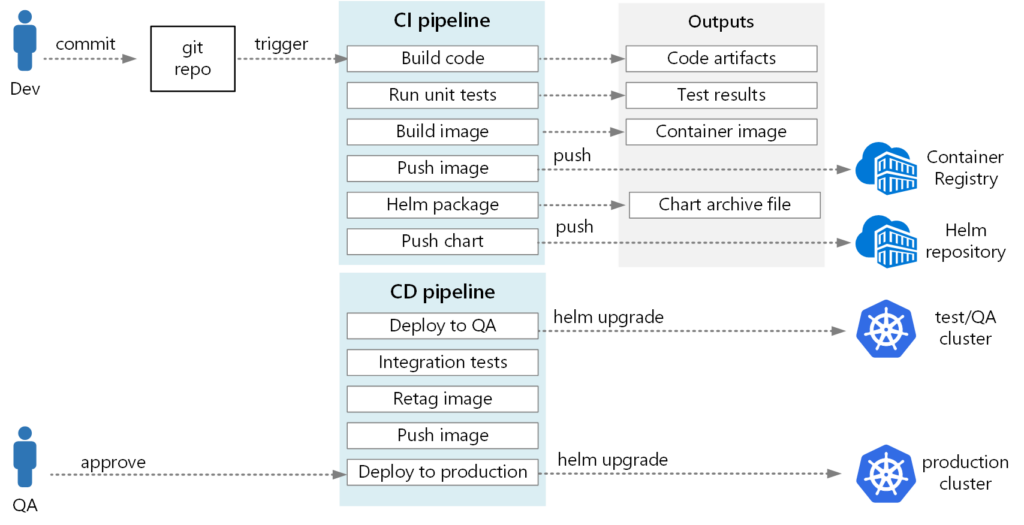Kubernetes is today’s leading container management platform, due to its comprehensive API and developer-friendly features. Using Kubernetes, you can create scalable and reliable applications that run on-premises systems and public clouds. Its out-of-the-box features allow it to distribute hundreds of instances over data centers and keep them up and running.
In order to catch up with the automation level of Kubernetes, developing and deploying applications requires more autonomy. This is where continuous integration (CI) and continuous delivery (CD) are the best cloud-native and modern approaches to building, testing, and releasing applications with minimum human interaction, as you can see below (Figure 1).

Figure 1: CI/CD pipeline (Source: Ubuntu Blog)
CI/CD tools work with a pipeline strategy and overtake the manual steps of getting the latest changes from the source code repository, compilation, test, verification, and deployment to the cluster. With Kubernetes, you need to extend CI/CD pipelines with a container registry, configuration manager, Helm, and multiple cluster environments, as shown in the image below.

Figure 2: CI/CD pipeline with Kubernetes (Source: Microsoft Azure)
In this blog post, we will discuss the challenges as well as best practices for CI/CD pipelines for Kubernetes. We’ll also share a list of popular tools that you should not miss when building an effective CI/CD pipeline for Kubernetes.
Challenges of Kubernetes CI/CD Pipelines
Designing and using a CI/CD pipeline is not easy, due to the architecture of microservices and the restless nature of Kubernetes. So, if we would need to summarize the challenges of a Kubernetes CI/CD pipeline, it would be in the following three categories:
- Automated testing: Automated testing is crucial when creating and deploying reliable applications in the cloud. You should test all of the developers’ commits thoroughly before moving to the following stages of the pipeline. This can be challenging while considering different cloud provider integrations and mocking Kubernetes API.
- Deployment and rollback: Kubernetes provides scalable and reliable deployment APIs so that it can release your applications to the cloud without downtime. Therefore, CD pipelines should also retain cloud-native deployment strategies, such as rolling upgrades, blue/green, or A/B testing. In addition, the pipeline should roll back to the “last working” version in case problems occur in the deployment. Therefore, designing an automated deployment and rollback strategy in your pipelines is critical.
- Scalability: When you use Kubernetes in production, it will be the home of tens—or even hundreds—of applications. In that case, the CI/CD tools you are using will be watching a large scale of source-code repositories and running multiple pipeline instances in parallel. Therefore, you need to design your CI/CD pipeline considering its scalability and allocate enough resources for its workers.
These challenges show that there is no silver bullet for designing and implementing a successful CI/CD pipeline for Kubernetes. However, there are widely accepted best practices, which we’ll discuss in the following section.
Best Practices for Kubernetes CI/CD Pipelines
Here are three best practices you can follow for your Kubernetes CI/CD pipelines:
- GitOps: GitOps is one of the newest ways to manage infrastructure and cloud-native applications using the source version control system—namely, Git. In this practice, all application and pipeline configurations are kept in Git side-by-side with the application’s source code.
- Deployment strategies: Deployment strategies are the methods of release, upgrade, and rollback of the applications. Widely known strategies include blue/green, canary, and A/B testing. You need to choose a set of deployment strategies and include them in your CD pipelines, as they can help minimize downtime and the risk of failure.
- Overall observability: CI/CD pipelines are the bridges between your source code and Kubernetes clusters. Therefore, you need to monitor the status of pipeline stages and create alerts and notifications for the responsible people. Observability of the CI/CD systems is essential because when the pipeline stages fail, you will not be able to create new releases and bugfix patches.
Fortunately, there are already some well-established tools that can help you follow these best practices, and you do not need to create your CI/CD software from scratch.
Kubernetes CI/CD Tools
Let’s review the five most popular Kubernetes CI/CD tools on the market, as well as their use cases.
GitHub Actions
GitHub is today’s leading source-code hosting service. It also provides a hosted CI/CD tool named GitHub Actions, which focuses on automating software build, test, and deploy from the source code living in GitHub repositories. Because GitHub Actions mainly deals with CI, it lacks some CD features, such as deployment strategies and cluster management. However, it is still worth looking at if you store your source code in GitHub.
GitLab CI
GitLab is the second most popular source-code hosting service, and it also provides a full-featured CI/CD tool. From a CI perspective, it implements all the popular features, including build, test, and validation. In addition, it offers crucial elements in the CD field, such as cluster management and canary deployments. GitLab CI is one of the leading solutions for Kubernetes CI/CD pipelines—and, of course, if you are storing your source code in GitLab.
Jenkins (Jenkins X)
Jenkins is one of the most widely known CI tools on the market, with its origins in Java. However, here we are highlighting Jenkins X, a complete CI/CD tool focused on Kubernetes. Jenkins X provides a highly opinionated approach to creating and deploying Kubernetes applications. It is extendable with the other CI/CD tools and cloud providers, but is not mature enough to be a reliable and solid CI/CD tool for your Kubernetes clusters.
Argo CD
Argo CD is a declarative continuous delivery tool focused on Kubernetes. It fetches the declarative application definitions from the source-code repository and builds and installs them to the cluster. In other words, it implements the GitOps pattern and works on the cluster side. Therefore, unlike other tools, Argo CD is also directly installed in the Kubernetes cluster. It has an active community and is highly adopted, so it’s worth checking if you want a tool with a GitOps mindset.
Spinnaker
Spinnaker is a CD tool created by Netflix and released as open-source in 2015. It focuses on managing the infrastructure and deployment cycle of applications; therefore, it is mainly categorized as a CD tool. It provides multi-cloud integrations, such as Kubernetes and Cloud Foundry. It’s a solid CD tool, but is highly sophisticated and most appropriate for large organizations.
Conclusion
We hope these best practices & tools help you improve your Kubernetes lifecycle management. While these tips can (and will) help minimize the chances of things breaking down, eventually, something else can go wrong – simply because it can.
This is the reason why we created Komodor, a tool that helps dev and ops teams stop wasting their precious time looking for needles in (hay)stacks every time things go south.
To learn more about how Komodor can make it easier to empower your teams to shift left and independently troubleshoot Kubernetes-related issues, sign up for our free trial.


